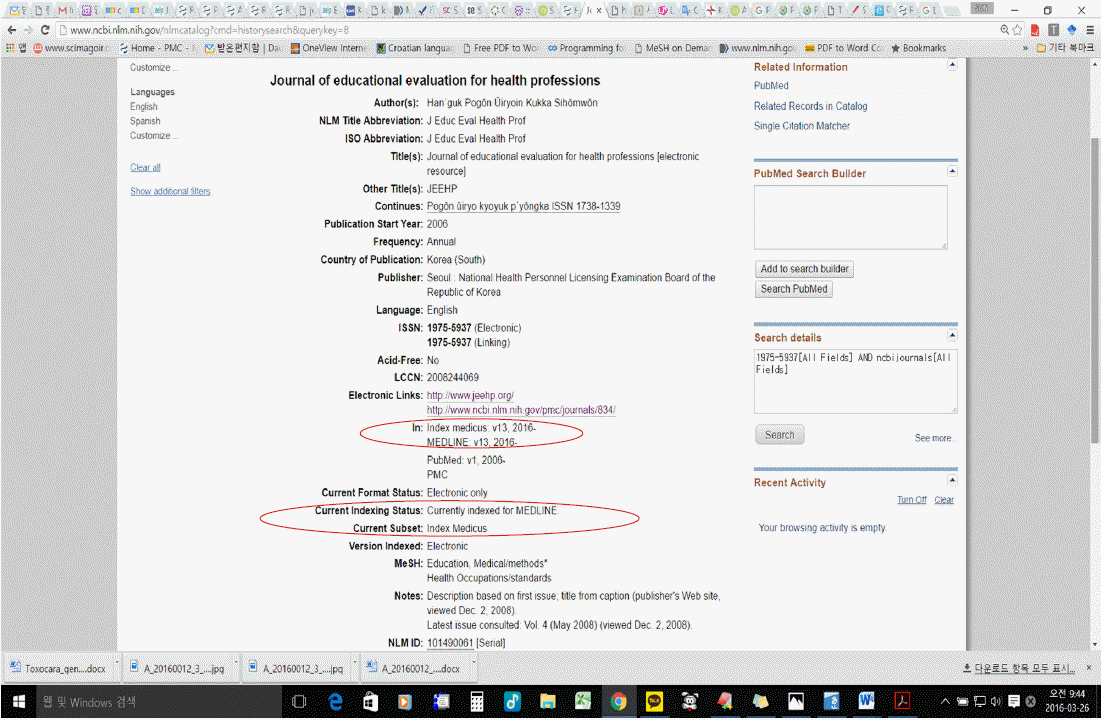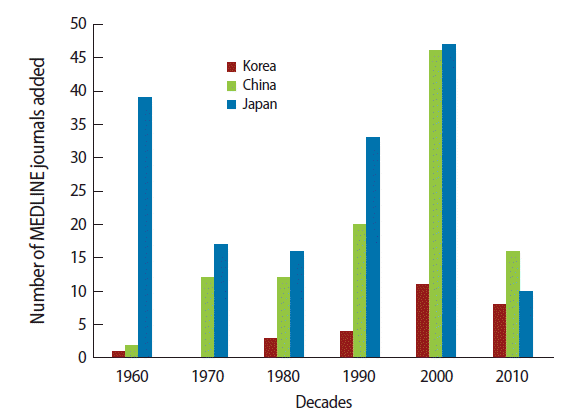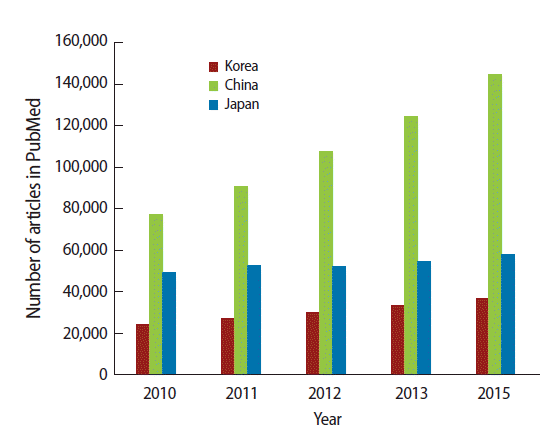Promotion to MEDLINE, indexing with Medical Subject Headings, and open data policy for the Journal of Educational Evaluation for Health Professions
Article information
On March 24, 2016, I received a follow-up message from the Literature Selection Technical Review Committee (LSTRC) of the Electronic Journals Support Team, United States National Library of Medicine (NLM), stating that “final approval for inclusion in MEDLINE/PubMed is contingent on the journal being fully compliant with current MEDLINE Indexing Policy for electronic journals found at http://www.nlm.nih.gov/bsd/policy/ejournals.html. Journal of Educational Evaluation for Health Professions has successfully complied with all three major areas: XML-tagged data, immediate access, and permanent preservation. MEDLINE indexing of Journal of Educational Evaluation for Health Professions will begin with Volume 13, 2016.”
Previously, I had received a notification letter on March 8, 2016, stating, “At the recent LSTRC meeting, the committee recommended your journal for inclusion in MEDLINE. MEDLINE citations are indexed with NLM Medical Subject Headings (MeSH®) and are directly searchable from NLM as a subset of the PubMed® database.” After reading the follow-up message, I checked the NLM Catalog, and found that the Journal of Educational Evaluation for Health Professions (JEEHP) is now indexed in MEDLINE (Fig. 1).

Screenshot of the Journal of Educational Evaluation for Health Professions indexed in MEDLINE from the National Library of Medicine Catalog [cited 2016 March 26].
There are two benefits in particular to inclusion in MEDLINE: being searchable from PubMed, and being indexed by Medical Subject Heading (MeSH). JEEHP has been searchable from PubMed since 2009 as it has been available through PubMed Central (PMC) since that time. The addition of MeSH details to journal articles, however, is very important in allowing articles to be found using detailed and specific searches. The U.S. National Library of Medicine describes MeSH as a “controlled vocabulary thesaurus [comprising] sets of terms naming descriptors in a hierarchical structure that permits searching at various levels of specificity” [1]. Articles with MeSH are more likely to be to be seen by researchers worldwide than those without MeSH.
As of March 2016, there are 299 journals from Korea in the National Center for Biotechnology Information (NCBI) database, of which 28 journals (9.6%) are currently indexed in MEDLINE. By comparison, there are 733 journals from Japan referenced in the NCBI database, of which 161 journals (22.0%) are currently indexed in MEDLINE. There are 758 journals from China referenced in the NCBI database, of which 108 journals (14.2%) are currently indexed in MEDLINE. There are 12,125 journals from the Unites States of America referenced in the NCBI database, of which 2,159 journals (17.8%) are currently indexed in MEDLINE. Fig. 2 shows the number of journals from Korea, Japan, and China added to MEDLINE chronologically. A total of 5,633 journals are currently indexed in MEDLINE as of March 2016. Therefore the proportion of journals from Korea indexed in MEDLINE is 0.50%. Thus, it was not easy for bio-medical journals from Korea to be included in MEDLINE.

Number of MEDLINE journals from Korea, China, and Japan added during each decade from the 1960s to the 2010s.
The small proportion of NCBI-referenced journals from Korea in MEDLINE (9.6%) prompted many editors of Korean medical journals to change the language of their journals so that they were exclusively English, and to produce full-text journal article tag suites (JATS) in XML to deposit in PubMed Central because the NCBI adopted a policy of automatically transferring the abstracts of PMC journals to PubMed. Since the first deposit of XML files into PMC in 2008, the number of PMC journals from Korea has reached 117 as of March 2016. It is a different situation for journals from Japan and China; the number of PMC journals from Japan and China, as of March 2016, is 30 and 43 respectively. Interestingly, 20 MEDLINE-indexed journals from Korea deposited JATS XML files in PMC. JEEHP has deposited full text XML files to PMC since 2009. The recent upgrade of many medical journals from Korea to international journals is attributed to PMC [2]. I believe that more medical journals from Korea will change their language to English and deposit full text JATS XML files in PMC. I also anticipate a rapid increase in the number of MEDLINE-indexed journals from Korea, owing to their leading position among Asian countries with regard to research. A total of 1,240,488 articles were added to PubMed in 2015. Of these, 36,792 articles are from Korea (3.0%). There has been a rapid increase of PubMed articles from East Asia. The recent increase in articles from Korea in PubMed will help to promote journals from Korea (Fig. 3).
In addition to the news of becoming a MEDLINE-indexed journal, I would like to announce an important policy change this year (as described in the recent revision of instructions to authors, available from http://jeehp.org/). To allow research results to be checked for accuracy and reproducibility, raw data or analysis data should be deposited in a public repository – for example, Harvard Dataverse (https://dataverse.harvard.edu/) or Figshare (http://figshare.com/) – and the address should be given in the “Methods” section. If a public repository is not available, data should be submitted to JEEHP. Exposure of data is negotiable with the editor, but the editor asks authors to keep to this policy wherever possible. I believe that this policy will support the transparency of data and analysis. This will also facilitate meta-analysis using raw data, and the sharing of data among researchers.
I extend my thanks to all authors, contributors and reviewers for their help and support in the promotion of JEEHP to a MEDLINE-listed journal. I will do my best to publish JEEHP continuously and maintain timely and complete full-text submissions to PMC for continued inclusion in MEDLINE.
Notes
Conflict of interest
No potential conflict of interest relevant to this article was reported.

